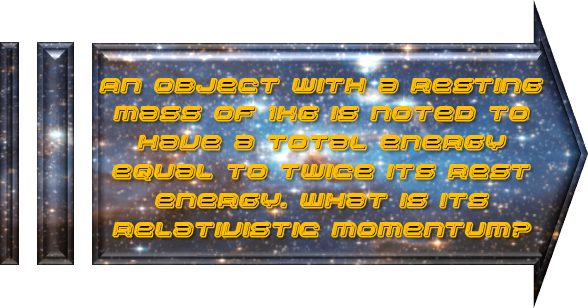Math Made Easy: Problem of the Day 136

More relativity! More relating different types of quantities! Some people donít like it when you try to relate different types of quantities. They arenít quite flexible enough to wrap their heads around relations between things like energy and momentum or forces and energy and the like, or worse, relationships in changes in one set of dimensions and how they affect another, different set of dimensions.
When we reach relativistic speeds, many different concepts and quantities become inextricably linked. You change one, and the others change. Each has direct effects on the others. Just as we learned in Problem of the Day 118 that observed mass, and thereby observed kinetic energy, increases as one increases velocity, so does the observed momentum of an object. This only follows since momentum is directly related to an objects mass and velocity: p = mv.
We could try to find the relative change in our objectís velocity, and from there its relative momentum. But we donít need to do that. Itís actually the long way around. Instead, we can go there directly from the objectís total energy. There is a relation between the objects total energy and its momentum and rest energy, and it looks like this:

So we can take that relation, and solve for the momentum, p. First letís move the resting energy (the m0c2 term) over to the total energyís side by subtraction. Iíll also put the momentum term on the left for ease of reading.

Now we divide both sides by c2, and then take the square root of both sides. This isolates our momentum completely, and gives us all known terms on the right-hand side.

I said known terms, even though we were never given a solid number for the objectís total energy. We donít need one. We can call its total energy E 1. So twice that is 2. Weíll refer to the speed of light in terms of C, so thatís just 1. We can do this because it keeps our units consistent, and the relativistic momentum turns out to be directly related to the difference in the resting and total energies. As far as the speed of light goes, Iím doing it as 1C since all but one of the cís cancel out, and itís the only velocity there, so itís important to remember that, so our answer will be in terms of kilograms times the speed of light (which gives us N s when we replace c with its value of 3x108 m/s ).

And thatís a crazy amount of momentum. To give an idea of just how much momentum that is, it would take a Saturn V Rocket a full 15 seconds to slow that 1 kilogram object down to rest, and thatís the most powerful rocket ever flown. A single large locomotive would need almost 10 minutes to slow down that one kilogram object to a stop.
Remember that, even if quantities look like they donít have the same kind of units, or even the same kind of dimensions, that doesnít mean theyíre not relatable. Our universe is deeply intertwined with itself, and most things, if you look deep enough, have connections to most other things, so there is probably a way to relate one to another if youíre just willing to go through the mathematical steps to do so, and clever enough to find them.
|



